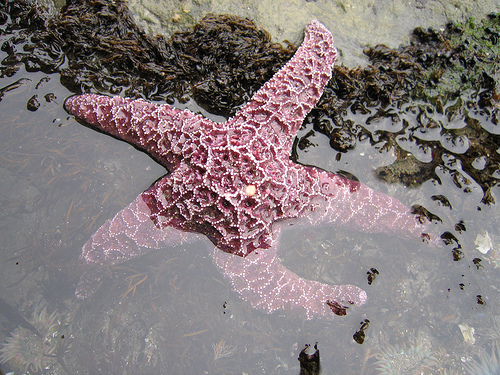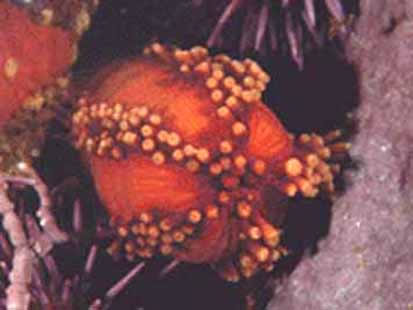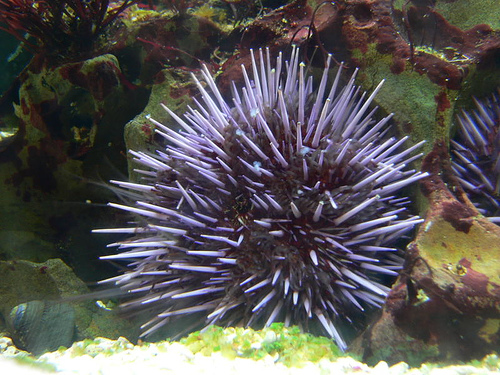
Here you will find some examples of the more common species in the Puget Sound region.
Home Biology Feeding Reproduction Site Species Summaries References

Pisaster Ochraceus .Photo from http://www.flickr.com/photos/fixiewrek/215731845/
The Purple or Ochre Sea Star (Pisaster ochraceus): The most common Sea Star in the Puget Sound region, it is found
from the intertidal zones to depths of 80 meters.It can be found on rocky substrates, in tide pools, or attached to docks
and pilings. It has a thick, stiff body with five arms and random patterns of calcarous spines on the aboral side. Size up to
35 cm (14 inches) in diameter.A carnivorous animal, their diet consists of mussels and other bivalves, barnacles, limpets
and snails.

Cucumaria miniata. Photo by D. Hunter
The Orange Sea Cucumber (Cucumaria miniata): Growing to a length of about 20 cm (8 inches), this echinoderm also
primarily occupies the intertidal zone but can live up to depths of 220 meters (740 feet). It has an elongated, bright
orange body and may have rows of purple tentacles in a radial symmetrical pattern around the body. It most often lives
in the crevices of rocks and will only have the bright orange feeding tentacles sticking out. A suspension feeder, it uses
its tentacles to capture bits of detritus from the water and then inserts them into the mouth.

Dendraster excentricus. Photo from Elasmodiver.com
The Pacific or Eccentric Sand Dollar (Dendraster excentricus): The Sand Dollar lives primarily in sandy sediments in
the intertidal zones and to depths of 39 meters (130 feet). They grow to roughly 10 cm (4 inches) in diameter with a
short, flattened test and numerous short spines that give it an almost "hairy" appearance. Coloration is usually a dark
purple but can be red-brown or lavender-grey. The white tests of dead animals are often found by beachcombers. The
Sand Dollar is a sediment feeder, scooping up the sands and processing whatever organic particles it can before
passing out the undigested particles.They are usually seen clustered together in large numbers. It gets its name from the
fact that several of the features on the aboral side are off-center or asymmetrical (hence "eccentric").

Strongylocentrotus purpuratus. Photo from Elasmodiver.com
The Purple Sea Urchin (Strongylocentrotus purpuratus): The Purple Urchin has a globular shape but is slightly
wider 9 cm (3 1/2 inches), than it is high 4.5 cm (1 3/4 inches). It is usually found on rocky substrates in the intertidal
zones and to depths of 157 meters (525 feet). As the name implies, the coloration is often purple, but can also be a
purple-green or have red highlights. It is most often found in coastal areas with large amounts of wave action and not
likely to be seen within the confines of Puget Sound. An herbivore, it feeds primarily on pieces of seaweed that it
scrapes off with it's oral structure known as the Aristotle's Lantern (see section on Feeding). It is more common to see
groups of them rather than single individuals.
“This webpage is part of the UWT Marine Ecology 2008 Class Project” : http://courses.washington.edu/mareco08